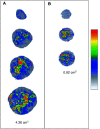Evaluation of hypoxia in an experimental rat tumour model by [(18)F]fluoromisonidazole PET and immunohistochemistry
- PMID: 15520822
- PMCID: PMC2409764
- DOI: 10.1038/sj.bjc.6602219
Evaluation of hypoxia in an experimental rat tumour model by [(18)F]fluoromisonidazole PET and immunohistochemistry
Abstract
This study aimed to evaluate tumour hypoxia by comparing [(18)F]Fluoromisonidazole uptake measured using positron emission tomography ([(18)F]FMISO-PET) with immunohistochemical (IHC) staining techniques. Syngeneic rhabdomyosarcoma (R1) tumour pieces were transplanted subcutaneously in the flanks of WAG/Rij rats. Tumours were analysed at volumes between 0.9 and 7.3 cm(3). Hypoxic volumes were defined using a 3D region of interest on 2 h postinjection [(18)F]FMISO-PET images, applying different thresholds (1.2-3.0). Monoclonal antibodies to pimonidazole (PIMO) and carbonic anhydrase IX (CA IX), exogenous and endogenous markers of hypoxia, respectively, were used for IHC staining. Marker-positive fractions were microscopically measured for each tumour, and hypoxic volumes were calculated. A heterogeneous distribution of hypoxia was observed both with histology and [(18)F]FMISO autoradiography. A statistically significant correlation (P<0.05) was obtained between the hypoxic volumes defined with [(18)F]FMISO-PET and the volumes derived from the PIMO-stained tumour sections (r=0.9066; P=0.0001), regardless of the selected threshold between 1.4 and 2.2. A similar observation was made with the CA IX staining (r=0.8636; P=0.0006). The relationship found between [(18)F]FMISO-PET and PIMO- and additionally CA IX-derived hypoxic volumes in rat rhabdomyosarcomas indicates the value of the noninvasive imaging method to measure hypoxia in whole tumours.
Figures


 , muscle (n=24; that is, front leg muscle n=12 and hind leg muscle n=12) □ and a body area 15 mm above the heart (n=12) ▪ on 12 randomly chosen 2 h p.i. images. Similarly, tumours (n=48)
, muscle (n=24; that is, front leg muscle n=12 and hind leg muscle n=12) □ and a body area 15 mm above the heart (n=12) ▪ on 12 randomly chosen 2 h p.i. images. Similarly, tumours (n=48)  were analysed on 2 h p.i. images. For all the tissues, cumulative histogram analysis was carried out.
were analysed on 2 h p.i. images. For all the tissues, cumulative histogram analysis was carried out.

Similar articles
-
[18F]EF3 is not superior to [18F]FMISO for PET-based hypoxia evaluation as measured in a rat rhabdomyosarcoma tumour model.Eur J Nucl Med Mol Imaging. 2009 Feb;36(2):209-18. doi: 10.1007/s00259-008-0907-x. Epub 2008 Aug 9. Eur J Nucl Med Mol Imaging. 2009. PMID: 18690432
-
Correlation of [18F]FMISO autoradiography and pimonidazole [corrected] immunohistochemistry in human head and neck carcinoma xenografts.Eur J Nucl Med Mol Imaging. 2008 Oct;35(10):1803-11. doi: 10.1007/s00259-008-0772-7. Epub 2008 Apr 18. Eur J Nucl Med Mol Imaging. 2008. PMID: 18421457
-
A comparative study of the hypoxia PET tracers [¹⁸F]HX4, [¹⁸F]FAZA, and [¹⁸F]FMISO in a preclinical tumor model.Int J Radiat Oncol Biol Phys. 2015 Feb 1;91(2):351-9. doi: 10.1016/j.ijrobp.2014.09.045. Epub 2014 Dec 6. Int J Radiat Oncol Biol Phys. 2015. PMID: 25491505
-
FMISO as a Biomarker for Clinical Radiation Oncology.Recent Results Cancer Res. 2016;198:189-201. doi: 10.1007/978-3-662-49651-0_10. Recent Results Cancer Res. 2016. PMID: 27318688 Review.
-
177Lu-Benzyl-diethylenetriamine pentaacetic acid-anti-carbonic anhydrase IX small immunoprotein A3.2009 Dec 2 [updated 2010 Jan 12]. In: Molecular Imaging and Contrast Agent Database (MICAD) [Internet]. Bethesda (MD): National Center for Biotechnology Information (US); 2004–2013. 2009 Dec 2 [updated 2010 Jan 12]. In: Molecular Imaging and Contrast Agent Database (MICAD) [Internet]. Bethesda (MD): National Center for Biotechnology Information (US); 2004–2013. PMID: 20641383 Free Books & Documents. Review.
Cited by
-
Measurement of hypoxia-related parameters in three sublines of a rat prostate carcinoma using dynamic (18)F-FMISO-Pet-Ct and quantitative histology.Am J Nucl Med Mol Imaging. 2015 Jun 15;5(4):348-62. eCollection 2015. Am J Nucl Med Mol Imaging. 2015. PMID: 26269773 Free PMC article.
-
Efficacy of gene therapy-delivered cytosine deaminase is determined by enzymatic activity but not expression.Br J Cancer. 2007 Mar 12;96(5):758-61. doi: 10.1038/sj.bjc.6603624. Epub 2007 Feb 20. Br J Cancer. 2007. PMID: 17311022 Free PMC article.
-
Tumor hypoxia imaging in orthotopic liver tumors and peritoneal metastasis: a comparative study featuring dynamic 18F-MISO and 124I-IAZG PET in the same study cohort.Eur J Nucl Med Mol Imaging. 2008 Jan;35(1):39-46. doi: 10.1007/s00259-007-0522-2. Epub 2007 Sep 5. Eur J Nucl Med Mol Imaging. 2008. PMID: 17786438 Free PMC article.
-
Dynamics of tumor hypoxia in response to patupilone and ionizing radiation.PLoS One. 2012;7(12):e51476. doi: 10.1371/journal.pone.0051476. Epub 2012 Dec 10. PLoS One. 2012. PMID: 23251549 Free PMC article.
-
Molecular imaging of hypoxia in non-small-cell lung cancer.Eur J Nucl Med Mol Imaging. 2015 May;42(6):956-76. doi: 10.1007/s00259-015-3009-6. Epub 2015 Feb 21. Eur J Nucl Med Mol Imaging. 2015. PMID: 25701238 Review.
References
-
- Airley RE, Loncaster J, Raleigh JA, Harris AL, Davidson SE, Hunter RD, West CML, Stratford IJ (2003) Glut-1 and CA IX as intrinsic markers of hypoxia in carcinoma of the cervix: relationship to pimonidazole binding. Int J Cancer 104: 85–91, doi: 10.1002/ijc.10904 - PubMed
-
- Ashida S, Nishimori I, Tanimura M, Onishi S, Shuin T (2002) Effects of von Hippel–Lindau gene mutation and methylation status on expression of transmembrane carbonic anhydrases in renal cell carcinoma. J Cancer Res Clin Oncol 128: 561–568, doi: 10.1007/s00432-002-0374-x - PubMed
-
- Ballinger JR (2001) Imaging hypoxia in tumors. Semin Nucl Med 4: 321–329, doi: 10.1053/snuc.2001.26191 - PubMed
-
- Bentzen L, Keiding S, Horsman M, Falborg L, Hansen SB, Overgaard J (2000) Feasibility of detecting hypoxia in experimental mouse tumours with 18F-fluorinated tracers and Positron Emission Tomography – a study evaluating [18F]Fluoromisonidazole and [18F]Fluoro-2-deoxy-D-glucose. Acta Oncol 39: 629–637 - PubMed
-
- Bentzen L, Keiding S, Horsman MR, Grönroos T, Hansen SB, Overgaard J (2002) Assessment of hypoxia in experimental mice tumours by [18F]Fluoromisonidazole PET and pO2 electrode measurements – Influence of tumour volume and carbogen breathing. Acta Oncol 41: 304–312 - PubMed
MeSH terms
Substances
LinkOut - more resources
Full Text Sources
Other Literature Sources

